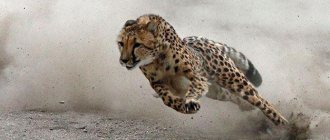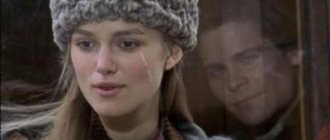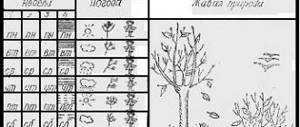Project “Use of ICT in the work of a music director in a preschool educational institution”
The system of musical education in kindergarten assumes not only a variety of types of musical education, but also variability in the forms of children’s musical activity. These are joint musical and educational activities, holidays, entertainment, theme evenings, concerts, performances, leisure evenings and more. For any form of musical activity, there are also presentations, videos, videos, slide shows, recordings of children's performances at matinees, educational educational films, and children's cartoons. At holidays and entertainment I use video presentations in several ways. The first is the animated background. I include videos to create a festive atmosphere. This often requires a lot of preliminary work. For example, for Mother's Day, I collected photographs of mothers and children in advance. The result was a very touching video that everyone liked. Another direction is when the video presentation becomes part of the storyline. For example, children collect leaves on the Miracle Tree during a matinee, or magical Autumn windows open when children complete certain tasks. Very often, at events, cartoon characters turn to children from the screen with some kind of request. All this allows you to diversify leisure activities, attract the attention of children, cause an emotional uplift, and create a joyful mood. I use a computer to select musical accompaniment for holidays, entertainment, musical activities and writing scripts, musical scores, etc.
ICT and variable forms of activity of a music director
I use ICT not only in working with children. Consultations and seminars for educators are also held using presentations and slide shows. Thus, when getting acquainted with the design of a music corner in a kindergarten group, teachers watch a colorful photo presentation, which shows various options for the arrangement of musical instruments in the group, and a video exhibition of homemade musical toys for independent musical activities of children in the group. At pedagogical councils I present multimedia presentations on the topics “One day in the life of a kindergarten”, “Experimental activities - a child in the world of sounds”, “Health-saving technologies in the work of the music director of a preschool educational institution”, etc. ICTs make it possible to present documentation in an accessible form for educators and specialists and administration (consultations, monitoring analysis, familiarization with the annual long-term plan and progress report). In the modern activities of a music director, one of the important functions is Internet communication. It facilitates the exchange of experience with colleagues from other regions of the country through various educational and personal sites. Among the most popular: https://www.musicalsad.ru/, https://kladraz.ru, https://maa.ru/, https://nsportal.ru, website of the festival of culture and art PEDMIX.ru and others . They allow you to find the necessary information in a form accessible to preschool children and in the shortest possible time. It is becoming a tradition to include presentations at parent-teacher meetings, showing photographs of children in the daily life of the kindergarten. When working with parents, I use the kindergarten website, where I post consultations, photographs from events, achievements of students, etc. I make presentations at parent meetings, and I use ICT to prepare materials on the problems of music education for children in parent corners. And what is especially important, ICT technologies provide great opportunities for processing and storing musical material. It should be noted that one of the innovative forms of working with parents is the opening of the official website of the kindergarten, where parents can get acquainted with the conditions, dynamics and originality of educational work with children in kindergarten. The necessary information is brought to the attention of parents on issues of ensuring the protection of the rights of the child, his upbringing, preparation for school, and the development of his abilities. The kindergarten website is a source of educational and methodological information. From the pages of the site, parents receive information on methods of preserving the health of children, their safety, rules of child behavior in the family and in society, useful tips on teaching and raising preschoolers. Many parents are interested in reading the materials on the site. Also, the most common communication technology and corresponding service in computer networks has become the technology of a computer method for sending and processing information messages, ensuring prompt communication between people. E-mail can be used by teachers for consultations, sending tests and professional communication with colleagues. Every day more and more teachers begin to engage in their own development of information resources and other ICT tools, many of which end up on the Internet. Even if the teacher is not involved in his own developments, he can use already created Internet resources. The ability to use the Internet allows you to keep abreast of events happening in teaching communities, track announcements of events (contests, seminars), receive advice on current issues, post your works in media libraries, get acquainted with the developments of the events of your colleagues - teachers, and store your files . Communication on forums with colleagues from all over Russia helps to move forward in the work of a music director. Social networks help the teaching community to make themselves and their activities known, where I share my work. Multimedia manuals are developed using Microsoft Office, PowerPoint, MovaviVideoEditor, CamtasiaStudio. At the present stage of development of information technology, it should be commonplace for a modern teacher to: search for the necessary information, work with e-mail, using information networks. The teacher must use local and global computer networks in everyday and further professional activities: be able to analyze the information received, independently find new friends and colleagues in different countries of the world, correspond, even hear and see them. Conclusion
Thus, with the help of ICT, information interaction between subjects of the information and communication subject environment is enhanced, the result of which is the formation of a more effective learning model, and motivation to study social disciplines increases.
Summary of a music lesson for the senior preparatory group of a preschool educational institution using ICT
Musical lesson in the senior or preparatory group of a kindergarten on the topic “Music and our health”
Author: Irina Aleksandrovna Zakharova, music director of the branch of MDOU DS No. 1 DS No. 3, Belinsky, Penza region. Description of work. The summary will be useful to kindergarten music directors, educators, and music teachers in elementary schools. Here is shown an option for presenting to children an idea of how music can influence human health (according to the age characteristics of children). There are problematic situations, various forms of work, an example of “good” and “bad” music, fairy-tale characters are used - Basilio the Cat and Alice the Fox. The lesson was shown at the “Teacher of the Year” competition in 2016 with children of different age groups (senior, preparatory). Photos and videos (amateur) are presented. A film for the lesson (minutes and seconds are indicated in the notes), I found it more convenient to use than a presentation. I hope my experience will be useful. Goal: formation of musical taste, ideas about how music affects human health. Tasks: to emotionally perceive music of a different nature and speak out about it;
develop the ability to convey the character of music with the help of plastic movements and artistic creativity; develop creative thinking and imagination, cognitive activity, vocal-choral, communication skills. Progress of the lesson.
1.Login. To the music, the children run like a snake into the hall. (entrance song “Path-toropinka” (00:03) Musical director: Guys, I’m very glad that the cheerful path led you to the music hall. Sit down at your convenience. (A fragment of the introduction of P.I. Tchaikovsky’s “Waltz of the Flowers” sounds ( 01:06) Musical director: Guys, what are you hearing now? (music) - Why do you think a person needs music? (answers) - Today we will talk not only about music. But what, you will find out by guessing riddle. We have all known for a long time Cow's milk Helps strengthen Children's ...... (health) - Do you think music can somehow influence human health? - Today we will listen and perform different music, and I think we will find the answer to the question does music affect our health, and if so, how does it do it? Now let's admire the landscapes, listen to the music and think about what feelings it conveys. 2. Tchaikovsky's "Waltz of the Flowers" - listening (fragment (01:32) Musical director : What mood does this music convey? - What is the name of this music, how many of you know? - Who wrote this music? -Who could dance to this music?
Musical director: Yes. This work was written by the famous Russian composer P.I. Tchaikovsky and called it “Waltz of the Flowers”. To this music, fairy-tale characters spin in a magical dance - a prince and princess surrounded by beautiful flowers. Let's imagine that we find ourselves in a fairy tale, turned into beautiful flowers and dancing along with everyone. Anyone who wants can decorate themselves with flowers. (children wear wreaths and ties with flowers) - Try to come up with movements that match the music yourself. On the clap we change the movement. 3. Plastic improvisation to the music of P.I. Tchaikovsky “Waltz of the Flowers” (03:11)
Musical director: Well done, you danced very beautifully. What effect do you think this music can have on human health? (it can improve health) - Why do you think so? (she brings goodness, joy and happiness, she makes your soul feel good. We also danced, but dancing is useful) - Why do you think that dancing is useful? (strengthens posture, develops muscles) - Yes, this music gives us happiness and health, let us, with the help of music, wish everyone health and say with a song - Good afternoon! 4. Logorhythmic (communicative) game - singing “Hello!” Hello, blue sky! (raise hands) Hello, golden sun! (close their hands on top in a semicircle) Hello, free breeze! (wave at themselves) Hello, little oak tree! (wave in front of them) We live in the same region. (pulled forward) I greet you all! (raise hands up)
5. “Good afternoon” lyrics. V. Suslova, music. Y.Dubravina - performance (04:50)
Musical director: Do you think this song can help us in some situation? (if you’re sad, she can cheer you up) - Why? (because the nature of the music is cheerful and joyful) - How can this song affect our health? - Why can it improve health (it gives joy, good mood, singing strengthens the lungs, develops breathing, improves the flow of blood) - Yes, if you sing correctly, it is good for health. What rules of proper singing do you know? (do not shout, breathe correctly, pronounce words clearly) - Well done, you said everything correctly. Now imagine that you find yourself in a forest clearing, sit down to rest, close your eyes and hear music.
6. Listening to Mariage d'Amour - Paul de Senneville - Spanish Richard Clayderman. (excerpt) (06:21) Musical director: The music ended and you opened your eyes. Now go to the easel and use colored crayons to convey the mood of the music on paper. Free visual activity. (with music) (07:20)
Musical director: Why did you choose these colors? (the music is light, gentle and calm, so the colors are light, gentle - yellow, pink, blue) - Well done. You did everything right, and I would like to give you a gift. There was a music box here... Where is she? Have you guys seen it? (Music((08:51) Basilio the Cat and Alice the Fox come in. They quarrel and push)
Cat: Give it back, I saw it first! Lisa: But I took it first! Cat: Give it back, I'll try to open it again. There could be gold or jewelry there! Lisa: I won’t give it, I won’t give it. You still don't have the key. Cat: here it is, here it is. Musical director: Oh, guys, it looks like we have guests. Hello, dear ones, you are in kindergarten. So, don't quarrel or swear, please. Lisa: Oh, kids! Cat: But she won’t give me the box. I saw her first! Lisa: I like her myself. True, there is no key to it. Well, that’s okay, I’ll try with my key (picks in the lock, loud, unpleasant music sounds (09:13) the cat and the fox get scared )
Musical director: (takes out the key, the music stops sounding) Yes, this is my chest. I prepared it to give the guys a surprise, but you took it without permission and look what you did. And this is not how music should sound at all! Guys, what can you say about the music you just heard? (it is rude, harsh, unpleasant, very loud) - What can you do to this music? (quarrel, fight, make faces) - Let's use crayons to depict the impressions of this music. Free visual activity The Fox and the Cat hang around the children. Fox: Take the yellow one Cat: Blue is better Musical director: Guys, tell the Cat and the Fox why you chose these colors? (she is unpleasant, scary, that’s why the colors are dark) - This box is a gift for the guys. And only a special key can open it correctly. Guys, what key can open the music box (I show three keys. Children choose the violin key, I open the box) - Look, guys, what’s here? (musical instruments)
Lisa: You guys will forgive us and take us to play with you. Cat: We won’t take anything without permission. Together: We promise. Musical director: Well, if you promise, the guys and I will forgive you. Take musical instruments. Let's see what kind of music this magic box will bring. The music will tell you a fairy tale, look at the screen and be careful.
7. Playing music on children's musical instruments “Good Master” (10:03) Musical director: What mood did the music convey? (children's answers) - How can it affect our health? (strengthen because it brings joy and fun) Fox and Cat: Thank you. Now we understand what music is useful and should be listened to. Now it's time for us to go. Goodbye, children. (leave, music (12:44) Musical director: Today we listened to different music. Look at your drawings. What kind of music do you want to listen to, the one you depicted in light, bright colors or the one you depicted in dark colors? Why? - What kind of music is useful for health? (one that is pleasant to listen to, that brings joy, bright, calm) - Well done guys. I was very pleased to communicate with you today. (music sounds, then quieter, then louder) 8. Exit. Musical director: Listen, guys , a cheerful path invites you to join the group, and a pleasant surprise awaits you there (the children run out of the hall like a snake)
Amateur video lessons. Video presentation for the lesson. I found it more convenient to use than just a presentation.
We recommend watching:
Summary of educational activities for the senior group on the topic: Autumn Summary of educational activities in the senior group “Journey to the magical world of musical instruments” Summary of educational activities in the senior group “Visiting Domisolka” Thematic music lesson in a preschool educational institution. Senior group
Similar articles:
Conversation in the senior group of kindergarten on the topic: How people use leather and wood
Lesson notes for the senior group of kindergarten
Synopsis of a musical educational lesson in kindergarten in the senior group. Music is the treasure of heaven
Summary of a music lesson in kindergarten in the senior group for Bird Arrival Day - March 22
Summary of a music lesson in kindergarten for older children on the topic “Peace through sports”
Possibilities of using ICT in music education of preschool children
Modern musical activity is a joint activity, during which a variety of methods, pedagogical technologies, computer technologies are used, electronic musical instruments, and new multimedia are used. All of the listed technical and software tools have their own specifics and influence the educational process in a certain way. They are designed not only to improve the effectiveness of the educational process, but also to provide the music director with ample opportunities for creative realization and professional growth.
In order to form and develop a stable cognitive interest in musical and artistic activities in children, the music director is faced with the task of making joint activities interesting, rich and entertaining. The material should contain elements of the extraordinary, surprising, unexpected, arousing interest in preschoolers in the educational process and contributing to the creation of a positive emotional learning environment, as well as the development of musical and creative abilities.
Therefore, the use of information and communication technologies in the educational field of “Music” becomes possible and relevant. Music and computer are combined into one. When interacting with children in cultural and leisure activities, you can use a synthesizer, a home theater, a karaoke center, multimedia, a computer with specially selected programs, and presentations.
We use our achievements in the field of ICT when conducting open classes for parents, at matinees and holidays. The use of interactive tools in the process of music education allows for a quick change of didactic material, helps to enhance the cognitive activity of students, and stimulates the development of thinking, perception, and memory. Already existing experience has shown that working with a laptop, demonstrating presentation materials, clips of famous children's songs, phonograms (which help in learning new material, consolidating and repeating) in joint activities improves pupils' perception of the material, significantly increases children's motivation to learn, actively involve them in the educational process, contribute to the development of their creative abilities, and activate the cognitive activity of children.
We use multimedia technologies in various directions.
What are their functions in the work of a preschool teacher-musician?
1. visual aid.
2. source of educational information.
3. a means of preparing speeches.
4. a means of preparing texts, musical material, and storing them.
Compared to traditional forms of education and training of older preschoolers, multimedia technologies have a number of advantages:
- presenting information on the screen in a playful way arouses children’s great interest in the activity;
- carries a figurative type of information that is understandable to children;
- movements, sound, animation attract the child’s attention;
— is an excellent tool for solving learning problems:
make the material accessible to perception not only through auditory analyzers, but also through visual ones. Thus, the music director can put into practice the idea of individualizing children's education.
- the use of a computer or synthesizer significantly expands the conceptual range of musical topics, makes the specific sound of musical instruments accessible and understandable to children, etc.
— become the basis for the formation of musical taste, the development of the child’s creative potential and the harmonious development of the personality as a whole.
A music director can use various educational ICT tools both in preparation for joint activities with children, and during (when explaining new material, learning songs, dances, repetition, to consolidate acquired knowledge), as well as during holidays and entertainment.
Multimedia presentations - electronic filmstrips, including animation, audio and video fragments - are the most common type of presentation of demonstration materials. The use of such information technology makes it possible to more effectively develop all types of perception and memory in children: visual, auditory, sensory, associative, etc.
Using the capabilities of the Power Point program, you can develop and use presentations on all types of musical activities:
- perception of music: while getting to know the work of a particular composer, the use of portraits, video illustrations for musical works, familiarity with genres of music, etc. You can use a program such as “Masterpieces of Music” by O.P. Radynova. It contains overview lectures on various areas of music, biographies of composers, audio and video fragments.
- m.r.d. and dancing: the use of mnemonic tables with the help of which children can perform various formations or learn dance elements.
- singing: using graphic images to learn various chants, exercises for the development of the vocal apparatus, using picture prompts to recognize and learn songs.
- music-did. games: to develop musical and auditory perceptions, a sense of mode and a sense of rhythm, using the presentations “Fun and Sad”, “Three Genres of Music”, “Determine the Rhythm”, etc.
- At entertainment and celebrations, you can also use slides as an illustrative, animated background for events.
- getting to know and playing the DMI: The “History of Musical Instruments” sections are a great help in your work. Children receive information about groups of musical instruments and hear their sounds.
Article “The use of information and communication technologies in music classes at preschool educational institutions”
USE OF ICT IN MUSIC CLASSES IN PRESENTER HOUSES
What is information and communication technologies - this is the process of preparing and transmitting information to the learner using a computer.
Informatization today is considered as one of the main ways to modernize the education system. Information and communication technologies are firmly entrenched in all areas of human life. Accordingly, the education system makes new demands on the upbringing and training of preschool children. The use of multimedia technologies in music classes provides a number of advantages: children perceive the material better, interest increases, learning is individualized, and creative abilities are developed. The use of various audiovisual means (music, graphics, animation) enriches the learning material. Multimedia technologies are characterized by the combination of various types of presented information (speech, music, drawing) and therefore have the greatest impact on the formation of a child’s personality.
ICT in music education of preschool children can be used as:
— Source of educational information;
- Visual material;
— A tool for preparing texts, musical material, and storing them;
— A means of preparing speeches and entertainment.
The use of ICT makes it possible to more effectively develop all types of perception in children: visual, auditory, sensory. Use all types of memory in class: visual, auditory, figurative, associative, etc.
In my work with children, I try to use presentations. Preparing presentations is a serious creative process, each element of which must be thought out and meaningful from the point of view of children’s perception. Children can visually become familiar with all the material studied during the school year. Taking into account the age characteristics of preschool children, an important point is to change types of activities.
Multimedia means of transmitting information mean: sound, graphics, text, video, organized in the form of a unified information environment. The predominant form of thinking of children of primary preschool age, in my opinion, is visual and figurative information.
I believe that it is most effective to use innovative methods of working with preschoolers in music classes: showing educational films, cartoons and films with musical accompaniment. For example, you can show children cartoons where characters play certain musical instruments. You can also use fairy tales that feature masterpieces of world classics that are relevant to a particular topic of the lesson.
For example, the purpose of showing presentations “Journey around the city”, “Music of our city” is to create a cultural and emotional space for children with the help of computer information technology, to get to know the city through the works of composers, artists, poets, whose life and work are connected with Chelyabinsk.
This form of work promotes the development of imaginative thinking in preschool children, the ability to highlight the features of means of expression, form ideas about the same artistic image in various types of art, and instill aesthetic taste.
Children, relying on specific visual images, compare, analyze, make certain logical conclusions, and react emotionally to works of fine art, music and art. Thus, a unified process of figurative perception and active mental activity of children is organized.
At leisure evenings, it is recommended to watch excerpts from cartoons based on the works with children. It is advisable to discuss characters and means of musical expression with children. For children of middle and early preschool age, demonstrate presentations on the biography of composers.
Using a computer for classes with preschoolers has a wide range of possibilities: showing presentations, video illustrations to accompany musical works when listening to music, quizzes, test tasks, competitions. To teach and test the acquisition of knowledge in preschool children, classes must be conducted in a playful way.
Thus, thanks to the use of modern technologies in music classes, the student turns from a passive listener into an active participant in the process, the lesson becomes more intense and interesting.
The following tasks are achieved with the help of ICT:
— development of musical abilities of preschool children;
- addition of auditory impressions and ideas of children;
— activation and development of emotional perception of music;
— formation of cognitive motivation in preschool children for musical activities.
Unlike conventional technical means of education, information and communication technologies make it possible not only to saturate the child with a large amount of ready-made, strictly selected, appropriately organized knowledge, but also to develop intellectual and creative abilities in preschool childhood, get acquainted with the natural world, and consolidate ideas about oneself and family , society, art.
In addition, in the process of planning and creating new tasks for correctional and developmental classes using a multimedia projector, the creative qualities of the teacher are developed and improved, and the level of his professional competence grows. The desire of an adult to diversify the activities of children,
However, I would like to note that the use of computer tasks does not replace the usual correctional methods and technologies of work, but is an additional, rational and convenient source of information, clarity, creates a positive emotional mood, motivates both the child and the teacher; thereby speeding up the process of achieving positive results at work.
We should not forget that the use of ICT in the musical education of preschool children is only a means for achieving the goals and objectives set for the teacher.
The leading role in musical education always remains with the music director!
Bibliography:
1. Gorvits Yu.M., Chainova L.D., Poddyakov N.N., Zvorygina E.V. New information technologies in preschool education [Text]/ Yu.M. Govrits-M.: LINK-IIPESS. 1998.
2. Fomicheva O. S. Raising a successful child in the computer age [Text] / O. S. Fomicheva - M.: “Helios ARV”. 2000.
3. Bitova A. L., Lipes Yu. V. Special music classes aimed at stimulating speech in children with severe speech disorders. Organization of a pedagogical environment for children with emotional-volitional disorders and communication disorders: Method. Recommendations for music teachers, speech therapists, educators [Text] / A.L. Bitova - M.: “Helios ARV”. 1994.
4. Filicheva T.B., Tumanova T.V. Children with general speech underdevelopment. Education and training. Educational and methodological manual [Text] – M.: “Gnome-Press”. 1999.
5.Medvedvedeva E.A.Musical education of children with developmental problems and corrective rhythm: A textbook for students of educational institutions of secondary vocational education [Text] / E.A. Medvedeva - M.: Publishing center




